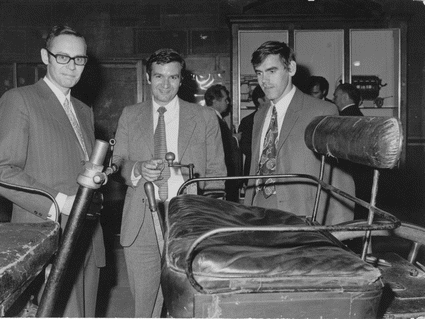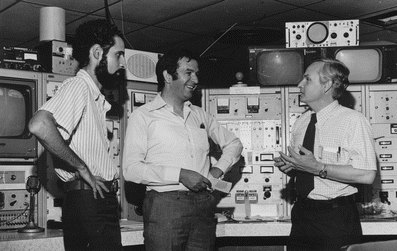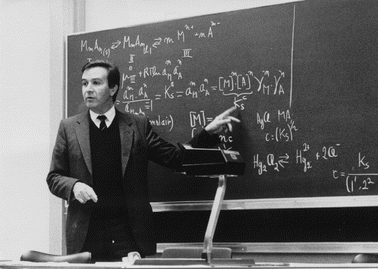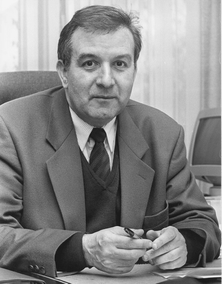Special editorial
A tribute to Freddy C. V. Adams on the occasion of his retirement
Scientist, mentor, statesman, administrator, colleague, and friend, Freddy Camiel Valentin Adams was born on July 10, 1938, in Lede, Belgium. Professor Adams has had a profound impact on virtually all aspects of elemental analysis and, indeed, on the field of analytical chemistry as a whole. This impact has arisen not only through his many publications and books, but also through his leadership in research, science education, and administration. The following narrative plus some thoughts and comments from some of his previous students provides a glimpse into the impact of this amazing scholar.
Freddy Adams has spent his entire academic career at the University of Antwerp, having joined the staff there in 1972. From 1973 to 1975 he was chairman of the department and from 1983 to 1995 served as Rector of the university. He established, and is currently the director of, the Centre of Micro- and Trace Analysis (MiTAC). He has published five books and more than 600 journal articles.
| Working with Professor Freddy Adams as a young postdoctoral scientist enabled me to be involved in a wide variety of scientific projects in a dynamic and progressive environment. The ability of Prof. Adams to promote the scientific career of young scientists is remarkable and has touched me deeply. I have felt many times positively influenced by phrases like ‘you are strong enough to go on’ or ‘you may go instead of me’, all coming from him at the right moment. Freddy has a sophisticated sense of humour and, behind his suit, he is able to surprise some people with a funny electronic anecdote or picture. In my opinion, several journal pages are far too short to share my experiences of ‘working with Prof. Freddy Adams’. I consider myself very lucky.Heidi Goenaga Infante (Postdoctoral Fellow 1999–2003) |
These accomplishments have been recognized in a number of important ways. Freddy received the Louis Gordon Memorial Award in 1979 and, with one of his students, was presented the 1984 Castaing Award for the best paper at the Meeting of the Microbeam Analysis Society. The Environmental Policy Prize was given to Freddy in 1990 by the Coca-Cola Foundation and the Pregl Medal of the Austrian Chemical Society in 1996. He was presented with an honorary doctorate by the Al. I. Cuza University in Iasi, Romania, in 1998. He remains an honorary member of the Romanian Chemical Society.
 | ||
| Plate1 Together with Richard Dams and Willy Maenhaut (colleagues at the Institute of Nuclear Sciences, University of Ghent, Belgium) at a conference in Paris (1970). Images kindly supplied by Professor Koen Janssens, Centre for Micro- and Trace Analysis, Belgium. | ||
In his scientific pursuits, Professor Adams has emphasized but not restricted himself to methods for elemental analysis. Indeed, his research has encompassed virtually every approach to measuring elements. For unambiguous elemental analysis, it is necessary to employ spectroscopic transitions that are not involved in bonding or, alternatively, to isolate atoms so their valence electronic transitions can be utilized. Accordingly, Professor Adams has employed nuclear transitions by means of neutron-activation analysis, inner-shell electronic transitions through X-ray fluorescence, valence-electron transitions in free atoms through atomic absorption and emission, and mass spectrometry of atomic ions by using spark-source mass spectrometry, ICP mass spectrometry, and laser-microprobe mass analysis.
| I started working under Freddy's supervision as a PhD student (1988–1992). At that time he was Rector of the University of Antwerp (UIA). In spite of his heavy administrative duties he remained a very good supervisor. He would always stand up for your interests as soon as he noticed you were devoted and if he made a promise he would keep to it, both qualities very much appreciated. After my PhD I spent another 8 years in his research group and during this period I learnt many things from him. Freddy has always been an extremely good manager and probably the most important thing I learnt from him is how to write research proposals and raise research funds. I do wish Freddy the very best with his retirement.Annemie Adriaens (PhD 1993) |
Fields of application of these techniques in the Adams laboratory have been numerous and important. They range from environmental speciation to the characterization of lead levels in French wines, from the provenance of archeological artifacts to the spatial microprobe characterization of particulates in fly ash. To indicate the significance and breadth of these investigations, illustrative examples will be taken from the broad list of Professor Adams's publications.
| When working on my PhD at UIA in the eighties, a colleague (Johan De Waele) was working on asbestos fibres in lung tissue of mesotheliome patients. He asked to obtain lung tissue from a patient from the university hospital (UZ) in Antwerp. Being the Rector in those days, Professor Adams arranged for this. An extremely enthusiastic Johan was so happy with his sample that, on returning from the hospital, he ran to Prof. Adams’ office, loudly announcing: “Prof., it has worked! I got my sample!” Proudly he held the transparent plastic box with the fresh bloody content under the nose of Prof. Adams, who tried to keep upright in his chair with a completely white face. The future samples had to be organised by De Waele himself, and Prof. Adams did not want to see any tissue again!Bert Raeymaekers (PhD 1986) |
In the area of secondary ion mass spectrometry (SIMS), a particularly significant publication1 reveals not only the quality of his science but also that Freddy is highly regarded and also extremely generous. This invited review article highlights more the work of others rather than his own efforts.
In the area of inorganic speciation, another Adams publication2 illustrates another aspect of his research philosophy. In this particular instance, one of Freddy's students, Monika Heisterkamp, was sent off to work in another laboratory because he felt her education could become better rounded by her doing so. This orientation toward pedagogy is obvious in the Adams laboratory and helps to explain the extremely high regard that his students and co-workers have for him.
This orientation toward education is clear elsewhere in Professor Adams's career. He pioneered PhD education at the University of Antwerp and has long been an advocate of improved doctoral training. His philosophical approach toward PhD training was apparent in an important lecture that he presented at the 1998 Euroanalysis Meeting.3
 | ||
| Plate2 Using proton-induced X-ray emission at Florida State University (Tallahassee, Florida, USA) for analysis of environmental samples together with John Winchester. | ||
Recent publications by the Adams group in the field of X-ray fluorescence spectroscopy have emphasized the use of synchrotron radiation. One other important innovation in this area was his use of tapered capillary optics to enable microscopic X-ray analysis.4 These developments have been made possible by the astounding growth in brightness of X-ray sources, at a rate that exceeds even Moore's Law. When coupled with capillary-based focusing optics, such sources permit the quantitative, non-destructive determination of elemental composition in extremely small spots. Unlike competitive techniques, the method is capable of being employed in air and for either conductive or non-conductive samples. The Adams group has used this method to examine microheterogeneity in samples of oil fly ash, to examine elemental distributions in art objects, and to image both metallic and non-metallic archeological specimens.5–8
| Professor Adams was always very demanding on his students. In the beginning we did not like that at all, but then we found out that he was also demanding on himself. This is an attribute that you get to appreciate in the long run. Freddy did everything he could to take care of those who worked for him. It was only when I had been away from Antwerp University for many years I started to realize how much Prof. Adams had meant to me, not only scientifically, but also in teaching social skills and diplomacy.Paul Geladi (PhD 1979) |
Although research by the Adams group in the field of environmental analysis has contributed in a number of important ways, a particularly interesting set of publications9,10 examines the release of halocarbons by marine algae in Antarctica. The region in which the algae were studied is the same as was initially explored by an early Belgian expedition, the first that overwintered in Antarctica with the ship Belgica. As a result of that early 1898 expedition, islands in the area bear Belgian names such as Antwerp Island, Brabant Island, and others. The Adams studies were, of course, important because volatile halocarbons play an important role in the catalytic decomposition of ozone in the stratosphere. Although many anthroprogenic and natural sources of volatile organohalogens exist, marine algae are among them. The method employed for these investigations was atomic emission spectroscopy by means of a microwave-induced plasma, especially appropriate for onboard determinations.
Not surprisingly, the Adams laboratory has also pursued inductively coupled plasma mass spectrometry, most recently with a time-of-flight mass analyzer. One very important publication in this field11 critically evaluates this relatively new method for elemental analysis. They found that a commercial axial ICP-TOFMS is highly competitive with a quadrupole-based instrument, although the sensitivity is somewhat lower. Extremely rapid data acquisition by the TOFMS permits both a qualitative and quantitative determination of at least 66 isotopes in an extremely short time. Moreover, simultaneous ion extraction into the TOFMS offers high-precision isotope-ratio measurements. The accuracy of the method was demonstrated through analysis of a standard reference material.
| I remember Professor Freddy Adams very well, as my teacher in analytical chemistry and then as the promotor of my doctorate thesis. I considered him a highly professional and efficient man. He also appeared to be one of the leading characters of what was, at that time, still a very young chemistry department at the University of Antwerp. I am particularly indebted to him for his help and support during the preparation of my thesis and I wish him a long and happy retirement.André Pilate (PhD 1980) |
In addition to these important research contributions, Freddy Adams has served as an effective statesman and an advocate for Analytical Chemistry and for science in general. He has served on the editorial boards of an extremely large number of journals and is the member for Belgium on the NATO steering committee on Science for Peace. He has also been involved in a Romanian project about the environmental chemistry of the River Prut in Moldavia. He has been the organizer of a large number of important scientific gatherings and has served as a tireless advocate of collaborative science in Belgium, throughout the European community, and indeed across the world.
The foregoing examples are meant to be only illustrative rather than comprehensive, but clearly show the tremendous impact that Freddy Adams has had on science and society. He has established an outstanding example for others to attempt to follow and has produced a lasting imprint on international science.
 | ||
| Plate3 Teaching analytical chemistry at the University of Antwerp Graduate School (1973). | ||
Gary Hieftje, Indiana University
On behalf of the JAAS Editorial Board
References
- A. Adriaens, L. Van Vaeck and F. Adams, Static secondary ion mass spectrometry (S-SIMS): Part 2: Applications in materials science, Mass Spectrom. Rev., 1999, 18, 48–81 CrossRef.
- A. M. Leach, M. Heisterkamp, F. C. Adams and G. M. Hieftje, Gas chromatography inductively coupled plasma time-of-flight mass spectrometry for the speciation analysis of organometallic compounds, J. Anal. At. Spectrom., 2000, 15, 151–155 RSC.
- Freddy Adams and Eric Mathieu, Euroanalysis 10, Basel, September 6–11, 1998, “Towards a closer integration of PhD training to industrial and societal needs” Search PubMed.
- L. Vincze, K. Janssens, F. Adams, A. Rindby, P. Engström and C. Riekel, Optimization of tapered capillary optics for use at the microfocus beamline (ID 13) at the European Synchrotron Radiation Facility, Adv. X-ray Anal., 1999, 41, 252–261 Search PubMed.
- G. Vittiglio, K. Janssens, F. Adams and A. Oost, Localised and non-destructive analysis of metallic artifacts from ancient Egypt by means of a compact m-XRF instrument, Spectrochim. Acta, Part B, 1999, 54, 1697–1710 CrossRef CAS.
- A. Adriaens, K. A. Yener and F. Adams, Analytical study using electron and ion microscopy of thin-walled crucibles from Göltepe, Turkey, J. Archaeol. Sci., 1999, 26, 1069–1073 Search PubMed.
- M. Wadsak, I. Constantinides, G. Vittiglio, A. Adriaens, K. Janssens, M. Schreiner, F. C. Adams, P. Brunella and M. Wuttmann, Multianalytical study of patina formed on archaeological metal objects from Bliesbruck-Reinheim, Mikrochim. Acta, 2000, 133, 159–164 CrossRef CAS.
- K. Janssens, G. Vittiglio, I. Deraedt, A. Aerts, B. Vekemans, L. Vincze, F. Wei, I. De Ryck, O. Schalm, F. Adams, A. Rindby, A. Knöchel, A. Simionovici and A. Snigirev, Use of microscopic XRF for non-destructive analysis in art and archaeometry, X-ray Spectrom., 2000, 29, 73–91 CAS.
- B. Giese, F. Laturnus, F. Adams and C. Wiencke, Release of volatile iodinated C1–C4 hydrocarbons by marine macroalgae from various climatic zones, Environ. Sci. Technol., 1999, 33, 2432–2439 CrossRef CAS.
- F. C. Adams, F. Laturnus and S. Slaets, Determination of volatile halocarbons from Antarctic macroalgae with purge and trap-GC and ECD or AED, 43rd International Conference on Analytical Sciences and Spectroscopy, Montreal, 10–13 August, 1997 Search PubMed.
- X. Tian, H. Emteborg and F. C. Adams, Analytical performance of axial inductively coupled plasma time of flight mass spectrometry, J. Anal. At. Spectrom., 1999, 14, 1807–1814 RSC.
| This journal is © The Royal Society of Chemistry 2003 |

